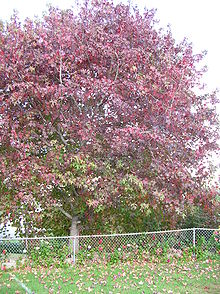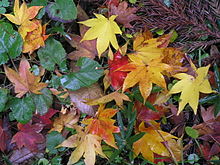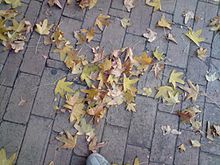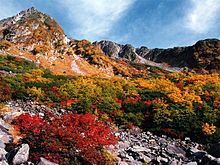- Autumn leaf color
-
Japanese Maple leaves (November 22, 2006)

 Maple leaves
Maple leaves
Autumn leaf color is a phenomenon that affects the normally green leaves of many deciduous trees and shrubs by which they take on, during a few weeks in the autumn season, one or many colors that range from red to yellow. The phenomenon is commonly called fall colors and autumn colors, while the expression fall foliage usually connotes the viewing of a tree or forest whose leaves have undergone the change. In some areas of Canada and the United States, "leaf peeping" tourism is a major contribution to economic activity. This tourist activity occurs between the beginning of color changes and the onset of leaf fall.
Contents
Chlorophyll and the green color
A green leaf is green because of the presence of a pigment known as chlorophyll, which is inside an organelle called chloroplast. When they are abundant in the leaf's cells, as they are during the growing season, the chlorophylls' green color dominates and masks out the colors of any other pigments that may be present in the leaf. Thus the leaves of summer are characteristically green.[1]
 In this leaf, the veins are still green while the other tissue is turning red. This produces a fractal-like pattern
In this leaf, the veins are still green while the other tissue is turning red. This produces a fractal-like pattern
Chlorophyll has a vital function: that of capturing solar rays and utilizing the resulting energy in the manufacture of the plant's food—simple sugars which are produced from water and carbon dioxide. These sugars are the basis of the plant's nourishment—the sole source of the carbohydrates needed for growth and development. In their food-manufacturing process, the chlorophylls themselves break down and thus are being continually "used up." During the growing season, however, the plant replenishes the chlorophyll so that the supply remains high and the leaves stay green.
In late summer, as daylight hours shorten and temperatures cool, the veins that carry fluids into and out of the leaf are gradually closed off as a layer of special cork cells forms at the base of each leaf. As this cork layer develops, water and mineral intake into the leaf is reduced, slowly at first, and then more rapidly. It is during this time that the chlorophyll begins to decrease.
Often the veins will still be green after the tissues between them have almost completely changed color.
A lot of chlorophyll is located in Photosystem II (Light Harvesting Complex II or LHC II), the most abundant membrane protein on earth. LHC II is where light is captured in photosynthesis. It is located in the thylakoid membrane of the chloroplast and it is composed of an apoprotein along with several ligands, the most important of which are chlorophylls a and b. In the fall, this complex is broken down. Chlorophyll degradation is thought to occur first. Recent research suggests that the beginning of chlorophyll degradation is catalyzed by chlorophyll b reductase, which reduces chlorophyll b to 7-hydroxymethyl chlorophyll a, which is then reduced to chlorophyll a.[2] This is believed to destabilize the complex, at which point breakdown of the apoprotein occurs. An important enzyme in the breakdown of the apoprotein is FtsH6, which belongs to the FtsH family of proteases.[3]
Chlorophylls degrade into colorless tetrapyrroles known as nonfluorescent chlorophyll catabolites (NCC's).[4] As the chlorophylls degrade, the hidden pigments of yellow xanthophylls and orange beta-carotene are revealed. These pigments are present throughout the year, but the red pigments, the anthocyanins, are synthesized de novo once roughly half of chlorophyll has been degraded. The amino acids released from degradation of light harvesting complexes are stored all winter in the tree's roots, branches, stems, and trunk until next spring when they are recycled to re-leaf the tree.
Pigments that contribute to other colors
Carotenoids
Carotenoids are present in leaves the whole year round, but their orange-yellow colors are usually masked by green chlorophyll.[1] As autumn approaches, certain influences both inside and outside the plant cause the chlorophylls to be replaced at a slower rate than they are being used up. During this period, with the total supply of chlorophylls gradually dwindling, the "masking" effect slowly fades away. Then other pigments that have been present (along with the chlorophylls) in the cells all during the leaf's life begin to show through.[1] These are carotenoids and they provide colorations of yellow, brown, orange, and the many hues in between.
The carotenoids occur, along with the chlorophyll pigments, in tiny structures called plastids within the cells of leaves. Sometimes they are in such abundance in the leaf that they give a plant a yellow-green color, even during the summer. Usually, however, they become prominent for the first time in autumn, when the leaves begin to lose their chlorophyll.
Carotenoids are common in many living things, giving characteristic color to carrots, corn, canaries, and daffodils, as well as egg yolks, rutabagas, buttercups, and bananas.
Their brilliant yellows and oranges tint the leaves of such hardwood species as hickories, ash, maple, yellow poplar, aspen, birch, black cherry, sycamore, cottonwood, sassafras, and alder. Carotenoids are the dominant pigment in coloration of about 15-30% of tree species.[1]
Anthocyanins
The reds, the purples, and their blended combinations that decorate autumn foliage come from another group of pigments in the cells called anthocyanins. Unlike the carotenoids, these pigments are not present in the leaf throughout the growing season, but are actively produced towards the end of summer.[1] They develop in late summer in the sap of the cells of the leaf, and this development is the result of complex interactions of many influences — both inside and outside the plant. Their formation depends on the breakdown of sugars in the presence of bright light as the level of phosphate in the leaf is reduced.[5]
During the summer growing season, phosphate is at a high level. It has a vital role in the breakdown of the sugars manufactured by chlorophyll. But in the fall, phosphate, along with the other chemicals and nutrients, moves out of the leaf into the stem of the plant. When this happens, the sugar-breakdown process changes, leading to the production of anthocyanin pigments. The brighter the light during this period, the greater the production of anthocyanins and the more brilliant the resulting color display. When the days of autumn are bright and cool, and the nights are chilly but not freezing, the brightest colorations usually develop.
Anthocyanins temporarily color the edges of some of the very young leaves as they unfold from the buds in early spring. They also give the familiar color to such common fruits as cranberries, red apples, blueberries, cherries, strawberries, and plums.
Anthocyanins are present in about 10% of tree species in temperate regions, although in certain areas — most famously Maine, New England — up to 70% of tree species may produce the pigment.[1] In autumn forests they appear vivid in the maples, oaks, sourwood, sweetgums, dogwoods, tupelos, cherry trees and persimmons. These same pigments often combine with the carotenoids' colors to create the deeper orange, fiery reds, and bronzes typical of many hardwood species.
 A display of vivid autumn leaves in eastern Vermont.
A display of vivid autumn leaves in eastern Vermont.
Cell walls
The brown color of leaves is not the result of a pigment, but rather cell walls, which may be evident when no coloring pigment is visible.[1]
Function of autumn colors
Deciduous plants were traditionally believed to shed their leaves in autumn primarily because the high costs involved in their maintenance would outweigh the benefits from photosynthesis during the winter period of low light availability and cold temperatures.[6] In many cases this turned out to be over-simplistic — other factors involved include insect predation,[7] water loss, and damage from high winds or snowfall.
Anthocyanins, responsible for red-purple coloration, are actively produced in autumn, but not involved in leaf-drop. A number of hypotheses on the role of pigment production in leaf-drop have been proposed, and generally fall into two categories: interaction with animals, and protection from non-biological factors.[1]
Photoprotection
 Some trees, such as this American sweetgum at Keokea, Maui, develop bold fall colors in subtropical or tropical areas.
Some trees, such as this American sweetgum at Keokea, Maui, develop bold fall colors in subtropical or tropical areas.
According to the photoprotection theory, anthocyanins protects the leaf against the harmful effects of light at low temperatures.[8][9] It is true that the leaves are about to fall and therefore it is not of extreme importance for the tree to protect them. Photo-oxidation and photo-inhibition, however, especially at low temperatures, make the process of reabsorbing nutrients less efficient. By shielding the leaf with anthocyanins, according to the photoprotection theory, the tree manages to reabsorb nutrients (especially nitrogen) more efficiently.
Coevolution
According to the coevolution theory,[10] the colors are warning signals towards insects that use the trees as a host for the winter, for example aphids. If the colors are linked to the amount of chemical defenses against insects, then the insects will avoid red leaves and increase their fitness; at the same time trees with red leaves will have an advantage because they reduce their parasite load. This has been shown in the case of apple trees where some but not all domesticated apple varieties unlike wild ones lack red leaves in autumn. A greater proportion of aphids that avoid apple trees with red leafs manage to grow and develop compared to those that do not.[11] A trade off moreover exists between fruit size, leaf color and aphids resistance as varieties with red leaves have smaller fruits suggesting a cost to the production of red leafs linked to a greater need for reduced aphid infestation.[11] Consistent with red leaved tree providing reduced survival for aphids, tree species with bright leaves tend to select for more specialist aphid pests than do trees lacking bright leaves (autumn colors are useful only in those species coevolving with insect pests in autumn).[12]
The coevolution theory of autumn colors was proposed by W. D. Hamilton as an example of evolutionary signalling theory.[12] Biological signals such a red leafs it is argued because they are costly to produce are usually honest and so signal the true quality of the signaller with low quality individuals being unable to fake them and so cheat. Autumn colors would be a signal if they are costly to produce, or be impossible to fake (for example if autumn pigments were produced by the same biochemical pathway that produces the chemical defenses against the insects).
The change of leaf colors prior to fall have also been suggested as adaptations that may help to undermine the camouflage of herbivores.[13]
See also: Deciduous and Plant defense against herbivoryMany plants with berries attract birds with especially visible berry and/or leaf color, particularly bright red. The birds get a meal while the shrub, vine or typically small tree gets undigested seeds carried off and deposited with the birds' manure. Poison Ivy is particularly notable for having bright red foliage drawing birds to its off-white seeds (which are edible for birds, but not most mammals).
Allelopathy
Researchers at New York's Colgate University have found evidence that the brilliant red colors of maple leaves is created by a separate processes than those in chlorophyll breakdown. At the very time when the tree is struggling to cope with the energy demands of a changing and challenging season maple trees are involved in an additional metabolic expenditure to create anthocyanins. These anthocyanins, which create the visual red hues, have been found to aid in interspecific competition by stunting the growth of nearby saplings in what is known as allelopathy. (Frey & Eldridge, 2005)
Tourism
Autumn coloration at Karasawa of the Hodaka Mountains in Japan. See also: Leaf peeping
See also: Leaf peepingAlthough some autumn coloration occurs wherever deciduous trees are found, the most brightly colored autumn foliage is found in four or five regions of the world: most of southern mainland Canada; Most of the eastern part of the United States as well as smaller areas of forest further west; Scandinavia, Northern, and Western Europe north of the Alps; the Caucasus region near the Black Sea, Russia and Eastern Asia, including much of northern and eastern China, as well as Korea, and Japan.[14][15]
Eastern Canada and the New England region of the United States are famous around the world[14] for the brilliance of their "fall foliage," and a seasonal tourist industry has grown up around the few weeks in autumn when the leaves are at their peak. Thick forest cover and distinct seasonal changes make this part of the world an ideal setting for the types of deciduous trees that produce wonderful fall foliage. Fall colors are typically at their peaks in early to mid October for much of the northern and interior parts of the area, late October for areas further south, and early November for the warmer subtropical areas of the region. Some television and web-based weather forecasts even report on the status of the fall foliage throughout the season as a service to tourists, the most well-known of which is The Weather Channel. Fall foliage tourists are often referred to as "leaf peepers". Fall foliage tours to the Rocky Mountain states, the northwestern United States and far western Canada are becoming more popular as well. The Japanese momijigari tradition is similar, though more closely related to hanami.[16] In Finland the time of the year is called ruska (russeting). In Latvia during russeting, leaf peeping is promoted both internationally and locally. Other lands may also promote this, but mushrooming may be more culturally significant, for example in Lithuania.[citation needed]
Climate influences
Fall foliage peak times in the United States
Compared to western Europe, North America provides many more arbor species (more than 800 species, about 70 oaks compared to 51 and three in Western Europe)[17] which adds many more different colors to the spectacle. The main reason was the different effect of the ice ages—while in North America, species could evade to warmer regions along north–south ranging mountains, this was not feasible in Europe.[18]
According to a study in the journal Global Change Biology, climate change delays the autumn spectacle of multi-colored leaves but increases forest productivity. The study suggests that rising carbon dioxide levels in the atmosphere act directly to delay the usual autumn spectacle of changing colors and falling leaves in northern hardwood forests.[19] The researchers found that the forests in North America and Europe stayed greener longer as CO2 levels rose, independent of temperature changes. However, the experiments were too brief to indicate how mature forests may be impacted over time. Also, the research suggests that other factors, such as increasing ozone levels in the part of the atmosphere closest to the ground, can negate the beneficial effects of elevated carbon dioxide.[20]
References
 This article incorporates public domain material from the United States Government document "the USDA Forest Service".
This article incorporates public domain material from the United States Government document "the USDA Forest Service".- ^ a b c d e f g h Archetti, Marco; Döring, Thomas F.; Hagen, Snorre B.; Hughes, Nicole M.; Leather, Simon R.; Lee, David W.; Lev-Yadun, Simcha; Manetas, Yiannis et al. (2011). "Unravelling the evolution of autumn colours: an interdisciplinary approach". Trends in Ecology & Evolution 24 (3): 166–73. doi:10.1016/j.tree.2008.10.006. PMID 19178979.
- ^ Horie, Y.; Ito, H.; Kusaba, M.; Tanaka, R.; Tanaka, A. (2009). "Participation of Chlorophyll b Reductase in the Initial Step of the Degradation of Light-harvesting Chlorophyll a/b-Protein Complexes in Arabidopsis". Journal of Biological Chemistry 284 (26): 17449–56. doi:10.1074/jbc.M109.008912. PMC 2719385. PMID 19403948. http://www.pubmedcentral.nih.gov/articlerender.fcgi?tool=pmcentrez&artid=2719385.
- ^ Zelisko, A. (2005). "AtFtsH6 is involved in the degradation of the light-harvesting complex II during high-light acclimation and senescence". Proceedings of the National Academy of Sciences 102 (38): 13699–704. Bibcode 2005PNAS..10213699Z. doi:10.1073/pnas.0503472102.
- ^ Hortensteiner, S. (2006). "Chlorophyll degradation during senescence". Annual Review of Plant Biology 57: 55–77. doi:10.1146/annurev.arplant.57.032905.105212. PMID 16669755.
- ^ Davies, Kevin M. (2004). Plant pigments and their manipulation. Wiley-Blackwell. p. 6. ISBN 1405117370.
- ^ Thomas, H; Stoddart, J L (1980). "Leaf Senescence". Annual Review of Plant Physiology 31: 83–111. doi:10.1146/annurev.pp.31.060180.000503.
- ^ Labandeira, C. C.; Dilcher, DL; Davis, DR; Wagner, DL (1994). "Ninety-seven million years of angiosperm-insect association: paleobiological insights into the meaning of coevolution". Proceedings of the National Academy of Sciences 91 (25): 12278–82. Bibcode 1994PNAS...9112278L. doi:10.1073/pnas.91.25.12278. PMC 45420. PMID 11607501. http://www.pubmedcentral.nih.gov/articlerender.fcgi?tool=pmcentrez&artid=45420.
- ^ Lee, David; Gould, Kevin (2002). "Why Leaves Turn Red". American Scientist 90 (6): 524–531. Bibcode 2002AmSci..90..524L. doi:10.1511/2002.6.524.
- ^ Lee, D; Gould, K (2002). "Anthocyanins in leaves and other vegetative organs: An introduction". Advances in Botanical Research Volume 37. Advances in Botanical Research. 37. pp. 1–16. doi:10.1016/S0065-2296(02)37040-X. ISBN 978-0-12-005937-9.
- ^ Archetti, M (2000). "The coevolution theory of autumn colours". Journal of Theoretical Biology 205 (4): 625–30. doi:10.1006/jtbi.2000.2089. PMC 1691721. PMID 10931756. http://www.pubmedcentral.nih.gov/articlerender.fcgi?tool=pmcentrez&artid=1691721.
- ^ a b Archetti, M. (2009). "Evidence from the domestication of apple for the maintenance of autumn colours by coevolution". Proceedings of the Royal Society B: Biological Sciences 276 (1667): 2575–80. doi:10.1098/rspb.2009.0355. PMC 2684696. PMID 19369261. http://www.pubmedcentral.nih.gov/articlerender.fcgi?tool=pmcentrez&artid=2684696.
- ^ a b Hamilton, W. D.; Brown, S. P. (2001). "Autumn tree colours as a handicap signal". Proceedings of the Royal Society B: Biological Sciences 268 (1475): 1489–93. doi:10.1098/rspb.2001.1672. PMC 1088768. PMID 11454293. http://www.pubmedcentral.nih.gov/articlerender.fcgi?tool=pmcentrez&artid=1088768.
- ^ Lev-Yadun, Simcha; Dafni, Amots; Flaishman, Moshe A.; Inbar, Moshe; Izhaki, Ido; Katzir, Gadi; Ne'eman, Gidi (2004). "Plant coloration undermines herbivorous insect camouflage". BioEssays 26 (10): 1126–30. doi:10.1002/bies.20112. PMID 15382135.
- ^ a b "Pest Alert". August 30, 1998. http://hflp.sdstate.edu/pestalrt/alert709.htm. Retrieved 2006-11-28.
- ^ Altman, Daniel (November 8, 2006). "Fall foliage sets Japan ablaze". Taipei Times. http://www.taipeitimes.com/News/feat/archives/2006/11/08/2003335441. Retrieved 2006-11-28.
- ^ http://www.jpn-miyabi.com/Vol.7/momijigari-e.html
- ^ Heinz Ellenberg, H. Ellenberg: Vegetation Mitteleuropas mit den Alpen: In ökologischer, dynamischer und historischer Sicht, UTB, Stuttgart; 5th edition, in German, ISBN 3825281043 1996[page needed]
- ^ [1] University of Hamburg Biology Server, in german, retrieved 11/2008
- ^ Taylor, Gail; Tallis, Matthew J.; Giardina, Christian P.; Percy, Kevin E.; Miglietta, Franco; Gupta, Pooja S.; Gioli, Beniamino; Calfapietra, Carlo et al. (2007). "Future atmospheric CO2 leads to delayed autumnal senescence". Global Change Biology 14 (2): 264–75. doi:10.1111/j.1365-2486.2007.01473.x.
- ^ "Forests Could Benefit When Fall Color Comes Late". Newswise. http://newswise.com/articles/view/543478/. Retrieved 2008-08-17.
Further reading
- Guy, Robert D.; Krakowski, Jodie (2003). "Autumn Colours – Nature's Canvas is a Silk Parasol" (PDF). Davidsonia 14 (4): 111–20. http://www.davidsonia.org/files/14_4_guy_autumn_colours.pdf. Retrieved 2007-05-18.
External links
 Media related to Leaves in autumn at Wikimedia Commons
Media related to Leaves in autumn at Wikimedia Commons- Autumnal Tints by Henry David Thoreau
- Photographing fall foliage: how to capture autumn colors with your camera
- Fall Foliage in Scandinavia
- Some technical articles on the evolution of autumn colors
- Fall Foliage: Why Leaves Change Color LiveScience, 16 October 2006
- Sanderson, Katharine (2007). "Why autumn leaves turn red". Nature. doi:10.1038/news.2007.202.
Categories:- Autumn
- Plant physiology
- Leaves
- Pigmentation
Wikimedia Foundation. 2010.







